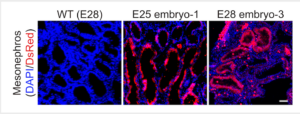A severe organ shortage plagues the progress of organ transplantation. One solution may be to generate human organs in other large mammals, however, that process is challenging. Now, researchers have successfully created chimeric embryos containing a combination of human and pig cells. When transferred into surrogate pig mothers, the developing humanized kidneys had normal structure and tubule formation after 28 days. This is the first time that scientists have been able to grow a solid humanized organ inside another species, though previous studies have used similar methods to generate human tissues such as blood or skeletal muscle in pigs.
This research is published in Cell Stem Cell in the paper, “Generation of a Humanized Mesonephros in Pigs from Induced Pluripotent Stem Cells via Embryo Complementation.”
“Rat organs have been produced in mice, and mouse organs have been produced in rats, but previous attempts to grow human organs in pigs have not succeeded,” said Lai Liangxue, PhD, principal investigator of the Guangzhou Institutes of Biomedicine and Health, Chinese Academy of Sciences, and Wuyi University. “Our approach improves the integration of human cells into recipient tissues and allows us to grow human organs in pigs.”

To produce human cells with superior “intra-niche competitiveness,” the team combined optimized pluripotent stem cell culture conditions with the inducible overexpression of two pro-survival genes (MYCN and BCL2). The cells were put into nephric-defective pig embryos lacking SIX1 and SALL1—two genes needed for kidney development.
The researchers transferred 1,820 embryos to 13 surrogate mothers. After either 25 or 28 days, they terminated gestation and extracted the embryos to assess whether the chimeras had successfully produced humanized kidneys.
The researchers collected five chimeric embryos for analysis (two at 25 days and three at 28 days post-implantation) and found that they had structurally normal kidneys for their stage of development and were composed of 50–60% human cells. At 25–28 days, the kidneys were in the mesonephros stage (the second stage of kidney development); they had formed tubules and buds of cells that would eventually become ureters connecting the kidney to the bladder.

“We found that if you create a niche in the pig embryo, then the human cells naturally go into these spaces,” said Zhen Dai, PhD, of Guangzhou Institutes of Biomedicine and Health. “We saw only very few human neural cells in the brain and spinal cord and no human cells in the genital ridge, indicating that the human pluripotent stem cells did not differentiate into germ cells.” This may be further prevented by knocking out further genes in the human pluripotent stem cells, which can be tested in future studies, the researchers say.
The team wants to allow the kidneys to develop for a longer duration. They’re also working to generate other human organs in pigs, including the heart and pancreas. The long-term goal is to optimize this technology for human organ transplantation, but that could take years. Growing a fully functional humanized organ in a pig would require some additional steps because organs are composed of multiple types of cells and tissues. In this study, the researchers created a niche for only one subset of cells, which meant that the kidneys had pig-derived vascular cells, and this could cause organ rejection if they were used in a transplant scenario.
“Because organs are not composed of just one cell lineage, in order to have an organ where everything comes from the human, we would probably need to engineer the pigs in a much more complex way and that also brings some additional challenges,” said Miguel A. Esteban, PhD, principal investigator of Guangzhou Institutes of Biomedicine and Health.
“Before we get to that late state of making organs that can be on the shelf for clinical practice, this method provides a window for studying human development,” said Esteban. “You can trace the human cells you’re injecting and manipulate them so that you can study diseases and how cell lineages are formed.”




